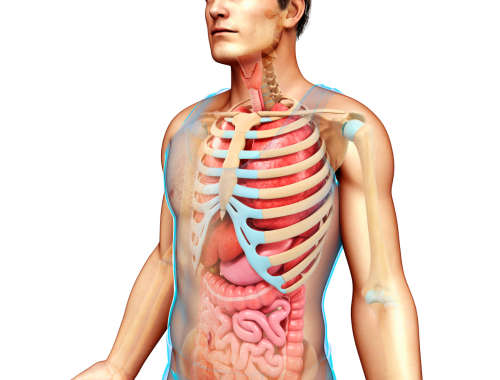Abs are abdominal muscles and ribs are ribs are bony framework of the thoracic cavity.

Abs
Abs are basically the abdominal muscles that form the stomach area, which is the front part of the belly.

Ribs
There are 24 ribs (12 pairs) in a human body. Any of the paired (2) curved bony or partly cartilaginous (having a skeleton of cartilage) rods that stiffen the protection layers of the body of most vertebrates.
Difference between abs and ribs
Definition
Abs
The abdominal muscles, also known as the belly or stomach, that are commonly referred to as abs.
Ribs
The chest and upper abdominal organs are encased in a cage made of ribs for protection. The average human has 12 pairs of ribs.
Structure
Abs
The transverse abdominis (the deepest layer of abdominal muscle), external obliques (a muscle of the anterior abdominal wall), and internal obliques (lies deep to the external oblique muscle), in addition to the rectus abdominis (the six-pack muscle), make up the abdominal muscles.
Ribs
Long, flat bones called ribs (a bone that curves round from your back to your chest) bend around the chest. They have direct connections to the sternum (breastbone or a narrow, flat bone, forming the middle portion of the front of the chest) in the front and the spine in the back. They are referred to as “true ribs” (ribs that directly articulate with the sternum with their costal cartilages) because of the costal cartilage that connects them to the sternum (breastbone). The final 5 pairs are termed to as “false ribs” (ribs that indirectly articulate with the sternum) and may connect to the sternum partially or not at all.
Function
Abs
In addition to supporting and stabilising the body and assisting with motions like bending and twisting, abdominal muscles also safeguard internal organs.
Ribs
The main job of a rib is to shield important organs like the heart and lungs from harm. When breathing, a rib moves, allowing the lung to enlarge.
Summary
The points of difference between abs and ribs have been summarized as below:

FAQ:
Are the abs over the ribs?
On the front of the body, between the ribs (a bone that curves round from your back to your chest) and the pelvis (also called bony pelvis or pelvic girdle), are the abdominal muscles. By controlling internal abdominal pressure (steady-state pressure in the abdominal cavity), the abdominal muscles support the trunk, provide movement, and retain organs in place.
Why can I see my ribs but not my abs?
You see your abs and not your ribs in a situation when you continue to have a belly fat even though you are extremely underweight. This type of fat is particularly harmful due to the health risks it indicates.
Why do my ribs stick out more than my abs?
Shallow breathing (thoracic breathing, costal breathing or chest breathing) is one of the main factors in rib flare (a posture that causes the lower ribs to protrude forwards). Without using the diaphragm, we breathe air into the upper chest at this point. Shallow breathing (thoracic breathing) is sometimes caused by stress, which over time develops into a habit, therefore in many situations people almost need to relearn the habit of normal breathing.
Why can I see my ribs but still have belly fat?
It’s common to have belly fat despite being thin enough to see your ribs. Now, if your abdomen (stomach area) is enlarged or distended and you can see your ribs, there may be a lot of reasons for this, including starvation, fluid retention (oedema or water retention), or even excessive organ growth.
Why am I skinny but have no abs?
You lack abdominal muscle thickness and that is why you have no abs. If you have a slim waist (slender-waisted), little body fat (skinny fat), and yet can’t see your abs (or abdominal, muscle), you need to work on building up the thickness of your Rectus Abdominis (a long muscle of the anterior abdominal wall or the muscle responsible for your six-pack). If the muscle bellies (composed of many bundles of fibres known as fasciculi) in your abs are weak and little, you will never be able to see them.
Why am I skinny but have a big rib cage?
It’s important to remember that your rib size is still influenced by the structure of your bones and your genetic makeup and cannot be readily modified. Even while you can’t directly reduce the size of your ribcage (basketlike skeletal structure that forms the chest, or thorax), you can focus on overall body organisation and lose weight.
At what weight will I see abs?
Your abs (a stomach, or abdominal, muscle) should be clearly evident in males with body fat levels of 6-17%. The range for females is fourteen to twenty-four % body fat. Your abs (a stomach, or abdominal, muscle) will begin to show definition at the higher end (seventeen percent for males and twenty four percent for females), and they will get more defined as the %age drops.
Why do I have an ab crack but no abs?
You’ll see in the pictures of models (who are mostly thin), who are quite slim, that they don’t actually have well developed abs (abdominal muscles). Genetically, some people may have more obvious grooves than others. They simply have the groove (a long, narrow space in the surface of a body part), which suggests that their core strength is weaker than their overall leanness.
How does a 4 pack look like?
When you have four distinct, observable, and well-defined muscles in your midsection, you have four-pack abs. These are often the four upper abs (the upper part of the rectus abdominis), which flatten and taper into a toned abdomen as they descend towards the groyne.
- Difference Between Global Warming and Greenhouse Effect - May 18, 2024
- Difference Between Vaccination and Immunization - March 3, 2024
- Difference Between Selective Mutism and Autism - February 25, 2024

